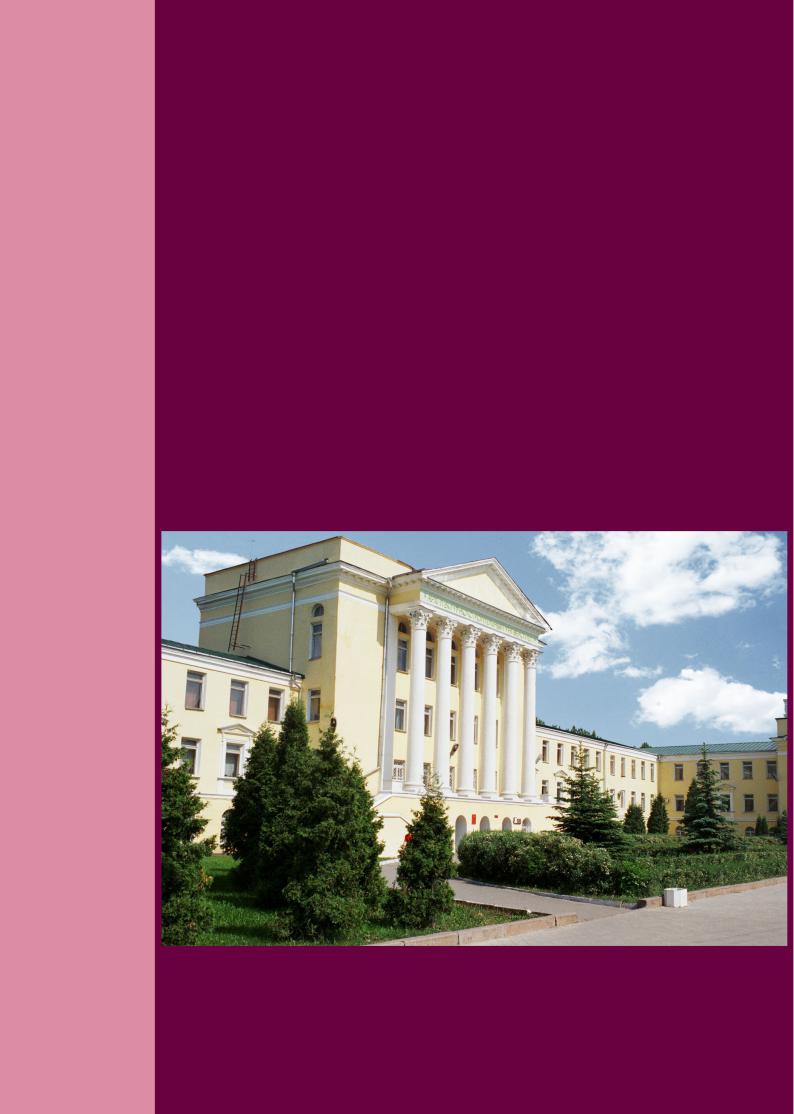
Russian Journal of Building Construction and Architecture
.pdf
RUSSIAN JOURNAL
OF BUILDING
CONSTRUCTION AND ARCHITECTURE

The journal is indexed/abstracted in:
Web of Science Core Collection
(Emerging Sources Citation Index)
(Thomson Reuters), USA
Ulrich's Periodicals Directory
(Bowker), USA
DOAJ
(Lund University), Sweden
Academic Search Complete
(EBSCO), USA
SOCOLAR
(China Educational Publications Import and Export Corporation –– CEPIEC), China
Google Scholar
(Google), USA
E-Library
(ООО «РУНЭБ»), Russia
J-Gate
(Informatics Ltd), India
ISSN 2542-0526
RUSSIAN JOURNAL
OF BUILDING CONSTRUCTION
AND ARCHITECTURE
N 2 (46)
BUILDING STRUCTURES, BUILDINGS AND CONSTRUCTIONS
BASES AND FOUNDATIONS, UNDERGROUND STRUCTURES
HEAT AND GAS SUPPLY, VENTILATION, AIR CONDITIONING, GAS SUPPLY AND ILLUMINATION
BUILDING MATERIALS AND PRODUCTS
TECHNOLOGY AND ORGANIZATION OF CONSTRUCTION
DESIGNING AND CONSTRUCTION OF ROADS, SUBWAYS, AIRFIELDS, BRIDGES AND TRANSPORT TUNNELS
BUILDING MECHANICS
THEORY AND HISTORY OF ARCHITECTURE, RESTORATION AND RECONSTRUCTION OF HISTORICAL
AND ARCHITECTURAL HERITAGE
ARCHITECTURE OF BUILDINGS AND STRUCTURES. CREATIVE CONCEPTIONS OF ARCHITECTURAL ACTIVITY
CITY PLANNING, PLANNING OF VILLAGE SETTLEMENTS
Voronezh 2020

Russian Journal
of Building Construction and Architecture
Periodical scientific edition
Published since 2009 |
Comes out 4 times per annum |
|
|
|
|
|
|
Founder and publisher: Voronezh State Technical University.
The territory of distribution — Russian Federation.
The articles are reviewed and processed with the program ANTIPLAGIARISM. This publication cannot be reprinted without the prior permission of the publisher, references are obligatory.
Previous name: «Scientific Herald of the Voronezh State University of Architecture and Civil Engineering. Construction and Architecture».
EDITORIAL BOARD
Editor-in-Chief: Melkumov V. N., D. Sc. in Engineering, Prof.,
Voronezh State Technical University
Boldyrev А.М., Corresponding Member of the Russian Academy |
Mailyan L. R., D. Sc. in Engineering, Prof., Don State Technical |
of Architecture and Engineering Science, D.Sc. in Engineering, |
University, Rostov, Russia |
Prof., Voronezh State Technical University, Russia |
Panibratov Yu. P., Academician of RAABS, Saint Petersburg State |
Bondarev B. А., D. Sc. in Engineering, Prof., Lipetsk State Tech- |
University of Architecture and Civil Engineering, Russia |
nical University, Russia |
Podolsky Vl.P., D. Sc. in Engineering, Prof., Voronezh State Tech- |
Gagarin V. G., Corresponding Member of RAABS, Moscow State |
nical University, Russia (Dep. ofthe Editor-in-Chief) |
University of Civil Engineering, Russia |
Slavinskaya G.V., D. Sc. in Chemistry, Prof, Voronezh State Tech- |
Gelfond А. L., Corresponding Member of the Russian Academy of |
nical University, Russia |
Architecture and Construction Science, D. Sc. in Architecture, |
Suleymanov А.М.,D. Sc. in Engineering, Prof., Kazan State Univer- |
Nizhniy Novgorod State University of Architecture and Construc- |
sity of Architecture and Engineering, Russia |
tion, Russia |
Fyedorov V. S., Academician of RAABS, Moscow State Universi- |
Enin A. Ye., PhD in Architecture, Prof., Voronezh State Technical |
ty of Railway Engineering, Russia |
University, Russia |
Fedosov S. V., Academician of RAABS, Moscow State University |
Karpenko N. I., Academician of RAABS, Research Institute of |
of Civil Engineering, Russia |
Building Physics (NIISF RAABS), Russia |
Chernyshov Ye. M., Academician of RAABS, Voronezh State |
Kirsanov М.N., D.Sc. in Physics and Mathematics, Professor |
Technical University, Russia |
(National Research University “Moscow Power |
Shapiro D. M., D. Sc. in Engineering, Prof., Voronezh State Tech- |
Engineering Institute”) |
nical University, Russia |
Kobelev N. S., D. Sc. in Engineering, Prof., Southwest State Univer- |
Shubenkov М. V., Academician of the Russian Academy of Archi- |
sity, Kursk, Russia |
tecture and Construction Science, D. Sc. in Architecture, Prof., |
Kolchunov V. I., Academician of RAABS, Southwest State Uni- |
Моscow Institute of Architecture (State Academy), Russia |
versity, Kursk, Russia |
Asanowicz Alexander, Prof., Dr. of Sn., Technical University of |
Ledenyev V. I., D. Sc. in Engineering, Prof., Tambov State Tech- |
Bialystok, Poland |
nical University, Russia |
Figovsky Oleg L., Prof., Dr. of Sn., Member of EAS, Israel |
Lyahovich L. S., Academician of RAABS, Tomsk State University |
Korsun V. I., D. Sc. in Engineering, Prof., The Donbas National |
of Architecture and Building, Russia |
Academy of Civil Engineering and Architecture, Ukraine |
Osipova N.N., D. Sc. in Engineering, Yury Gagarin Saratov State |
Nguyen Van Thinh, Prof., Dr. of Sn., Hanoi University of Archi- |
Technical University, Russia |
tecture, Vietnam |
Editor: Kotlyarova E. S. Translator: Litvinova O. A. Executive secretary: Mikhnevich I.V.
Publication date 06.10.2020. Format 60×84 1/8. Conventional printed sheets 12,8. Circulation 500 copies. Order 177. Number of the certificate of registration of the media ПИ № ФС 77-67855
Issued by the Federal Service for Supervision of Communications, Information Technology, and Mass Media (Roskomnadzor)
Price is subject to change
THE ADDRESS of EDITORIAL AND THE PUBLISHER OFFICE:
room2230,84 20-letiya Oktyabrya str., Voronezh, 394006, Russian Federation Tel./fax: (473)2-774-006; e-mail: vestnik_vgasu@mail.ru
Published in Printing Office of Voronezh State Technical University 84 20-letiya Oktyabrya str., Voronezh, 394006, Russian Federation
© Voronezh State Technical University, 2020
CONTENTS |
|
HEAT AND GAS SUPPLY,VENTILATION,AIR CONDITIONING, |
|
GAS SUPPLY AND ILLUMINATION........................................................................................... |
6 |
Medvedeva О. N., Astashev S. I. |
|
Development of an Optimal Placement Algorithm |
|
for Electrochemical Protection of Underground Steel Gas Pipelines ....................................... |
6 |
TECHNOLOGY AND ORGANIZATION OF CONSTRUCTION...................................................... |
18 |
Gorbaneva E. P., Mishchenko А. V. |
|
Information Modeling of Real Estate at the Stage of Survey Works...................................... |
18 |
DESIGNING AND CONSTRUCTION OF ROADS,SUBWAYS,AIRFIELDS, |
|
BRIDGES AND TRANSPORT TUNNELS.................................................................................... |
36 |
Samodurova T. V., Gladysheva O. V., Alimova N. J., Boncheva E. A. |
|
Modeling the Snow Deposit Process on the Highways in the FlowVision............................. |
36 |
Senibabnov S. A., Andrianov K. А., Zubkov A. F. |
|
Method of Development of Technology for the Device of Road Structures |
|
Using Asphalt Granulate............................................................................................... |
51 |
Uglova E. V., Shiryaev N. I. |
|
Increasing Performance of Road Layers From Porous Asphalt ............................................. |
71 |
Elshamy M. M. M., Tiraturyan A. N. |
|
Using Application of an Artificial Neural Network System |
|
to Backcalculate Pavement Elastic Modulus......................................................................... |
84 |
CITY PLANNING,PLANNING OF VILLAGE SETTLEMENTS.................................................... |
94 |
Ilyichev V. А., Kolchunov V. I., Ptichnikova G. A., Kormina A. A. |
|
Urban Environment Design: New Methodological Approaches |
|
Based on the Biosphere Compatibility Paradigm (Part 1)...................................................... |
94 |
INSTRUCTIONS TO AUTHORS.............................................................................................. |
109 |
5

Russian Journal of Building Construction and Architecture
HEAT AND GAS SUPPLY,VENTILATION,AIR CONDITIONING,
GAS SUPPLY AND ILLUMINATION
DOI 10.36622/VSTU.2020.2.46.001 UDC 622.691.24
О. N. Medvedeva1, S. I. Astashev2
DEVELOPMENT OF AN OPTIMAL PLACEMENT ALGORITHM
FOR ELECTROCHEMICAL PROTECTION
OF UNDERGROUND STEEL GAS PIPELINES
Yuri Gagarin State Technical University of Saratov1, 2
Russia, Saratov
1D. Sc. in Engineering, Prof. of the Dept. of Heat and Gas Supply, Ventilation, Water Supply and Applied Hydro and Gas dynamics, tel. (8452)99-88-93, e-mail: medvedeva-on@mail.ru 2PhD student of the Dept. of Heat and Gas Supply, Ventilation, Water Supply and Applied Hydro and Gas dynamics, tel. (8452)99-88-93
Statement of the problem. The paper considers the process of complex periodic corrosion inspection in order to assess the effectiveness and improve the operational reliability of the corrosion protection system (CPS) using the example of on-site technological networks of the underground gas storage Elshanskaya.
Results. The technical condition of the electrochemical protection means, the level of active protection and the technical condition of pipelines of the underground gas storage were assessed, the object was protected by its length and time, and zones of negative influence of constant and stray currents were identified. A method is proposed for determining the optimal number and locations of cathodic protection stations (CPS).
Conclusions. Based on the research results, a commissioning method is proposed that provides the optimal technological mode of operation of electrochemical protection means (EChP), and proposals have been developed to ensure the effectiveness of diagnostics and the safety of further operation of gas distribution pipelines. The implementation of this approach in the design of EChP facilities can lead to a significant reduction in energy consumption during operation.
Keywords: underground gas storage, anticorrosive protection systems, gas pipeline, direct current, stray current, safety.
Introduction. The gas industry is one of the essential sectors of the Russian economy. Russia is the global power supply leader with the most powerful gas transportation system and a management object not to be found elsewhere in the world. According to the PJSC Gazprom, the length of gas networks is over 172.6 thousand km.
© Medvedeva О. N., Astashev S. I., 2020
6
Issue № 2 (46), 2020 |
ISSN 2542-0526 |
An important way of ensuring the reliability and safety of the functioning of existing gas distribution systems is the introduction of new progressive technologies, materials, technological equipment, measuring instruments and metrology for a higher economic efficiency, reliability and safety.
At underground gas storages (UGS), the pipeline transport system is a complex structure which includes underground gas pipelines with welded joints, bends, transitions mostly made of steel and anti-corrosion protection of the system –– active (electrochemical protection) and passive (insulation surfacing) [1, 8, 13, 20, 23].
Active protection, which is fairly easy to maintain and repair, and passive protection of underground gas pipelines of UGS facilities are aimed at resisting corrosion of the pipeline material which is evaluated based on its reliability [9, 11, 17, 19].
Currently corrosion protection of engineering structures is a major technical and economic issue. Corrosion resistance of underground engineering networks plays a considerable role in the construction and operation of gas transportation facilities. In accordance with the regulatory documents (GOST R 51164-98 (ГОСТ) Steel Main Pipelines. General Requirements for Corrosion Protection and GOST (ГОСТ) 9.602-2016). A unified system of protection against corrosion and aging) to ensure the efficiency of corrosion protection, the following requirements must be met:
––value of the polarization potential (protective potential without an ohmic component) for operating steel structures should range from (–0.85) to (–1.15) V for the copper-sulfate reference electrode during the entire service life of the object;
––depending on the diameter and specific operating conditions, a reinforced type of protective surfacing with quality control of anti-corrosion materials, surfacing technology, properties of the finished surfacing, etc. should be employed on pipelines in areas of heightened corrosion hazard.
The major issue that arises in evaluating the economic efficiency of complex protection against corrosion is the optimization of the parameters of electrochemical protection, since the data on the choice of effective anti-corrosion surfacings is broadly presented in relevant literature [5]. Based on the analysis of the structure of the directions of use of electricity at the facilities of gas distribution systems, the specific consumption of electricity by ECP plants per 1 m2 of a gas pipeline area is 0.8––0.85 (kWatt h)/m2.
The purpose of the study is to assess the potential of energy saving and efficiency of its implementation from the introduction of new technologies and materials in relation to the tech-
7

Russian Journal of Building Construction and Architecture
nological consumers of electrical energy prevailing in gas distribution, i.e. electrochemical protection tools, using the example of on-site technological networks of a compressor shop of the Yelshanskaya UGSF.
The major goals are:
––to analyze the sources of hazard during long-term operation of pipelines of the gas distribution network;
––to justify the methods and technology for the reconstruction of electrochemical protection tools;
––to develop guidelines for reducing energy consumption for the operation of electrochemical protection tools to ensure the efficiency and safety of further operation of the gas distribution system.
1. Analysis of factors affecting the technology of reconstruction of ECP facilities. According to the current regulatory documents (GOST (ГОСТ) 9.602-2016. Unified System of Corrosion Protection), the major issue of reconstruction is to provide underground structures with cathodic polarization of the required level along the entire length of the gas network and in terms of electrochemical protection. When selecting methods for ECP reconstruction, directions of achieving a greater efficiency in the operation of cathodic protection stations can be the optimization of their placement at facilities in relation to the routes of underground gas pipelines for a technologically sound minimum number of electrochemical protection tools, the required degree of redundancy and a guaranteed level of corrosion protection of underground steel gas pipelines and structures as well as a decrease in the total operating costs and a possible decrease in energy consumption of ECP facilities by changing the initial installation scheme of devices [2, 4, 5, 14, 15, 18, 19, 25]. This should take into account [3, 6, 17, 21]:
––resistivity of soils at the site of laying steel gas pipelines considering the boundaries of zones of different corrosive aggressiveness of soils;
––resistance of insulating surfacing of steel gas pipelines;
––magnitude of stray currents;
––location of ECP facilities;
––availability of adjacent underground communications and information on the parameters of their electrochemical protection;
––total power losses of the RMS consisting of productive (natural losses of the cathodic protection station determined by the difference of 100 % and the efficiency of the RMS) and nonproductive losses including losses in drainage cables; losses in contact nodes of the cathodic
8
Issue № 2 (46), 2020 |
ISSN 2542-0526 |
protection installation; power losses associated with high resistance to spreading of currents of the anode ground electrode; losses from longitudinal resistance of the protected gas pipeline; power losses associated with an increase in the output current and voltage of the RMS with a deterioration in the quality of the insulation surfacing of the pipeline.
The choice of directions, methods and technologies for the reconstruction of ECP facilities including the development of proposals on the prospects for the development of the gas distribution network should be carried out based on a detailed analysis of the design schemes of the existing corrosion protection system and analysis of the operation of the ECP facilities [12, 22, etc.].
Solutions for the reconstruction of ECP facilities can be the following:
––use of a viable scheme for the allocation of tools of VCZ and ECP;
––replacement of ECP means according to the principle of operation and the criteria of efficiency and power;
––conditional sectioning of the gas pipeline;
––introduction of tools of regulation of operating modes and telemechanics [7].
The low efficiency of ECP for gas pipelines that have been in operation for more than 20 years is accounted for by a decrease in the protective potential and thus high costs for maintaining it within the required boundaries. An increase in the number or capacity of cathode stations may be required under the below conditions:
––a significant increase in the length of the gas network due to the connection of new consumers;
––damage to the insulating coating of gas pipelines as well as the impossibility or inexpediency of their restoration;
––introductionofadjoiningcommunicationsandtheirinclusion inthesystemofjointprotection;
––necessity to carry out the removal of gas pipelines beyond the boundaries of new construction facilities (gas pipeline bypasses of production sites).
The experience of practical diagnostics of gas distribution networks enables us to highlight a number of features [10, 24]:
––due to deterioration of insulation and wear of anodes designed for 20 years cathode stations gradually reduce the protection arm and thus over time an increase in their number is required;
––in the areas of stray currents and biological corrosion (soils of complex biogenicity), the highest efficiency of active electrochemical protection is achieved;
9
